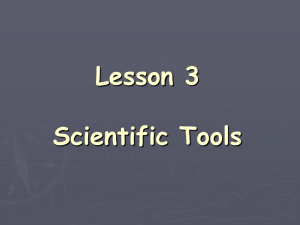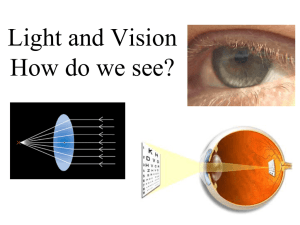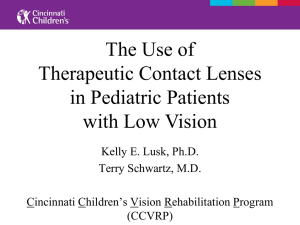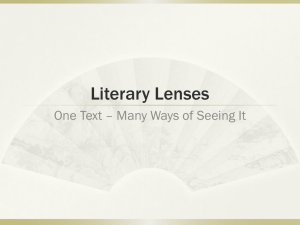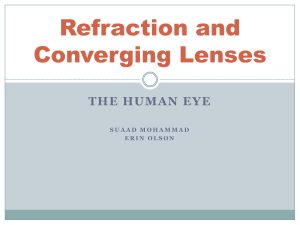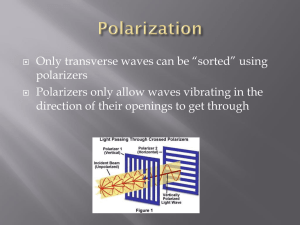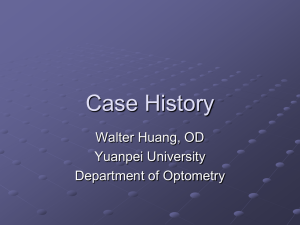Visual Fatigue Syndrome - Nebraska Optometric Association
advertisement
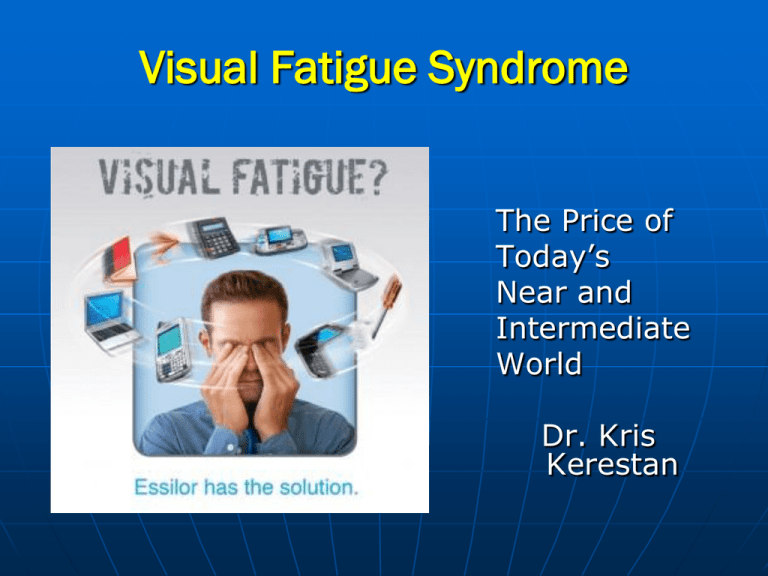
Visual Fatigue Syndrome The Price of Today’s Near and Intermediate World Dr. Kris Kerestan Fundamental Shift in Use of Vision Past: Primarily used Distance vision Today: Primarily use Intermediate/Near Fundamental Shift in Use of Vision Most professionals require extended intermediate and near viewing Accountants Attorneys Engineers Business administrators Architects Computer technology Designers Medical/allied health Widespread Computer Use Work, Home, School: • Over 55% use computers at work • Out of 100 million in US – 50% of workday is spent at a computer Widespread Computer Use 73% of U.S. adults use computers 71% access the internet In a recent study of more than 1,000 patients 25 years and older, respondents averaged between 6 and 7 hours per day at a computer Widespread Computer Use In the past decade, computer use among children in the United States has increased dramatically… Consider these statistics: 94 percent of American families with children have a computer in the home with access to the Internet Widespread Computer Use The amount of time children ages 8 to 18 devote to entertainment media (including computer and video games) each day has increased from 6.19 hours in 1999 to 7.38 hours in 2009 Widespread Computer Use In 2009, 29 percent of American children ages 8 to 18 had their own laptop computer, and kids in grades 7 through 12 reported spending an average of more than 90 minutes texting on their cell phones Visual Fatigue Today’s visual demands place greater stress on near and intermediate vision than ever before… More than 70% of 143 million Americans who work on a computer are affected by visual fatigue on a daily basis according to the AOA Studies show that eye strain and bothersome visual symptoms occur in up to 83% of computer users Visual Fatigue Approximately 10 million eye exams are performed annually in the U.S. due to vision problems related to computer use, making it a major public health issue 71% of those patients examined already wear corrective lenses for myopia, hyperopia, astigmatism or presbyopia but still have visual fatigue and eye strain Visual Fatigue Computer use is the most common source of visual strain and fatigue, but cell phones, handheld electronic devices and video games also may cause visual strain What is Visual Fatigue Syndrome? A visual condition consisting of a sum of TREATABLE symptoms including: Headache Loss of focus Blurred vision Burning of the Eyes Tired Eyes What is Visual Fatigue Syndrome? A visual condition consisting of a sum of TREATABLE symptoms including: Red Eyes Dry Eyes Neck and Shoulder Pain Overall general Fatigue What is Visual Fatigue Syndrome? “The complex of eye and vision problems related to near work which are experienced during or related to computer use.” --American Optometric Association VFS- On the Rise 50-90% of computer users experience visual symptoms 22% of computer users experience musculoskeletal disorders Contributing Factors – The Patient Condition of the patient’s eyes and visual system Working environment Work habits The eyes leading the body Too much staring, not enough blinking Contributing Factors – The Computer Position of the monitor • Distance from the eyes • Location relative to eye level Nature of the image • Difficult to focus on pixel images • Eyes tend to relax to a point beyond the screen (resting point of accommodation) • Constant refocus needed, tiring the eyes Contributing Factors – The Office Environment Inappropriate lighting Reflections from the computer screen or outside sources Poor ergonomics Dry and poor quality of office air Detection and Diagnosis of VFS based on patient SYMPTOMS… During eye health exam, must screen every patient by asking specific questions regarding their computer use, hobbies, reading and any visual fatigue symptoms that may accompany these activities May use a specific patient questionnaire or add to case history form What Specific Questions should we ask our patients? 1. How many hours per day are you on a computer or other electronic device at work and/or home? 2. Do you have any hobbies that require you to use your eyes up close? 3. Do your eyes ever feel tired or strained while on the computer? 4. Do you ever have blurred or out of focus vision while on the computer? What Specific Questions should we ask our patients? 5. Do your eyes ever feel dry or get red while using the computer? 6. Do you experience headaches with computer or electronic device use or while engaging in your hobby? 7. Do you experience neck or shoulder pain while using the computer? 8. Do you feel overall fatigue during or after computer use? Detection and Diagnosis of VFS based on CLINICAL FINDINGS… What clinical tests will aid the doctors and staff in the diagnosis of VFS? •Refractive errors •Binocular vision •Accommodative problems •Presbyopia and near vision correction •Dry eyes Diagnosis of VFS VFS Symptoms + Clinical findings = VFS diagnosis Who is affected by Visual Fatigue Syndrome? Emmetropes, Myopes, Hyperopes & Astigmats Non-presbyopes & presbyopes Spectacle lens wearers Contact lens wearers Refractive surgery patients Visual Fatigue can affect anyone at any age…Child, Teen, Young to Mature Adult Treating VFS using Computer Eyewear 1. 2. 2. 4. Single Vision Lenses or Readers “Anti-Fatigue” Lenses for Non-Presbyopes Near Variable Focus “Computer” Lenses for Presbyopes Progressive lenses Single Vision Computer Lenses In the past most lenses prescribed in computer glasses were Single Vision because not many other lens options were available Although SV lenses sometimes are an adequate solution for near tasks, the range of focus is extremely limited to one set distance. Patients are unable to walk around or see other distances in the office, so must constantly be taking on and off Single-Vision Lenses Most presbyopes wearing single vision lenses for reading and up-close work have blurred mid-range vision One solution is to move mid-range objects closer, but that is not always possible Another solution is an extra pair of single vision lenses for mid-range use; usually purchased from a pharmacy Single Vision Lenses For those ages 13 to 29, add +0.50 to their spherical distance correction For those age 30 and over wearing Single Vision, add +0.75 to their spherical distance correction These glasses are intended for use at computer/intermediate distance only and will cause blur at all other distances **Always Rx with AR coating** Progressive Lenses Distance Zone Unwanted Blur Near Zone General Purpose PAL Progressive lenses usually require more power change from top to bottom and therefore are not the best option Consequently, they produce more blur As adds increase, there is less stable and narrow power in intermediate area Optometrists’ Quotes “Up until now I basically gave up on these patients that have visual fatigue symptoms. I didn’t feel like I had anything to offer them in my clinical arsenal.” “There really are not enough products for us to pick from for dealing with some of these accommodative disorders that we’re identifying.” “The progressives don’t cut it for those patients who spend great deals of time on the computer.” Increasing Demand for New Computer Lens Technologies Despite significant regular computer use by over 75% of the population, only 3% to 4% of Americans today wear eyeglasses to relieve vision problems at a computer. Why?? • Not receiving appropriate diagnosis and treatment • Not aware of lens options available Newer Lens Solutions for Visual Fatigue Syndrome Addresses the following: • Different diagnoses by the OD such as accommodative VFS in pre-presbyopic patients or true presbyopic VFS • Must have lens options to treat a broad range of patient types and ages Newer Lens Solutions for Visual Fatigue Syndrome New category of lenses under “Visual Fatigue” Anti-Fatigue—A primary wear pair for non-presbyopes or emerging presbyopes who suffer from VFS Variable Focus “Computer”---A task specific lens for presbyopes who suffer from VFS “Anti-Fatigue” Computer Lens Solution Treating VFS with “Anti-Fatigue” Lenses Who is it for? Non-Presbyopic patients suffering from VFS symptoms Emerging Presbyopes Individuals who use near vision for extended periods doing activities such as reading, texting, electronic device use, paperwork, etc. Treating VFS with “Anti-Fatigue” Lenses How do they work? Use as the primary pair to replace a patients single vision lenses Provides a slight +0.60D “power boost” in the lower part of the lens Provides greater patient comfort and reduced visual fatigue than standard single vision correction by allowing the eye muscles to relax thereby decreasing the accommodative effort “Anti-Fatigue” Lenses How do they work? Concept: SV lens with distance vision (exactly as in a regular SV) w/a slight power variation (+0.6 D) in bottom part of lens to give some comfort in near vision, preventing and relieving visual fatigue +0.6 D power variation reached at 12mm from center = down gaze of 26° Sustains the accommodative effort Aspheric, so little or no distortion Compatible with all frame types => 23 mm B ***Only available with Non-glare*** “Anti-Fatigue” Lens “Anti-Fatigue” Fitting & Mounting Center pupil fitting height 13 mm minimum 23 mm minimum B measurement Monocular Distance PDs “Anti-Fatigue” Lenses Key Patient Types 35 to 45 year olds just starting to need slight plus for reading Myopes or Hyperopes aged 13 to 34 years when they indicate VFS symptoms of tired eyes, eye strain or others “Anti-Fatigue” Lens Essilor Anti-fatigue is only lens available in this category Variable Focus “Computer” Lens Solution Treating VFS with Variable Focus “Computer” Lenses Who is it for? Task specific wear by Presbyopes who spend extended time at intermediate and near viewing Meant to be used as a second pair to complement a patient’s primary pair of progressives Treating VFS with “Computer” Lenses How does it work? Intermediate Vision : Wide and comfortable “Computer “ lenses provide full vision at intermediate distance by accommodating a patient’s natural posture and workplace ergonomics Near Vision : Smooth transition Wide near area that provides a smooth transition for looking at the keyboard or documents Distance Vision : Functional and efficient Offers clear vision at full distance within an office setting to most patients, allowing for effective sight at all distances “Computer” Lens Contains an intermediate field of vision designed to offer full coverage of the screen area. Lens power specifically tailored for clear screen vision and frequent movements from keyboard to screen to surroundings. The design was based on user observations; lenses let you keep a natural posture: a 30° angle between the positions for viewing keyboard and screen. These lenses should NOT be worn for driving or other distance viewing activities. “Computer” Lens - Benefits • Comfortable viewing at distance, intermediate, and near • Wide clear intermediate area • Small area of viewing at distance to see across office • No more head tipping – correct intermediate power is placed at center of lens These lenses should NOT be worn for driving or other distance viewing activities. Near Variable Focus (NVF) Lens “Computer” Design “Computer” Lens Key Patient Types Any presbyope indicating VFS symptoms Also perfect lens for activities at intermediate and near – hobbies, remodeling, sewing, auto work, Optometrists, Optometric Assistants, etc. “Computer” Lenses Available Essilor “Computer” Lens Zeiss “Business” and “Access” Computer Lens Shamir “Office” Computer Lens Specific Fitting techniques and Lens parameters available through Sales Reps. Next Steps Put a plan together to: • Identify patients and educate them on lens options • Prescribe the best lens for their needs • Become comfortable using Anti-Fatigue and Computer Lenses to treat their VFS Additional Steps to Relieve VFS Use Proper Lighting Decrease both bright sunlight coming in and replace bright overhead fluorescent lighting with full spectrum bulbs or floor lamps Minimize Glare AR coating, Anti glare screen, paint white walls a darker color in matte finish Additional Steps to Relieve VFS Adjust screen Brightness, contrast, text size and color Blink more - 5X less when using computer Rewets eyes to decrease dryness and irritation Artificial tears Relax Focusing 20-20-20 rule - look away from computer Q 20 mins, 20 ft away for 20 sec. Additional Steps to Relieve VFS Frequent breaks Two 15 min breaks plus 4 mini 5 min breaks through day Stand up, walk around, stretch arms, legs, back and neck Modify Work Station Copy stand next to monitor, screen 20-24 inches from eyes and 10-15 degrees below eyes, good posture Gunnar High Definition Lenses ***Digital Performance Eyewear*** Total Lens and Frame technology addressing the needs of the most demanding digital device users Gunnar High Definition Lenses ***Digital Performance Eyewear*** Reduces visual stress, eyestrain and digital eye fatigue Wrap design for maximum field of clear vision Proprietary amber tint to increase contrast ***Considered the Ultimate*** ***Gaming Lenses*** Gunnar High Definition Lenses ***Digital Performance Eyewear*** Gunnar High Definition Lenses ***Digital Performance Eyewear*** Thank You for your Attention!! ???
